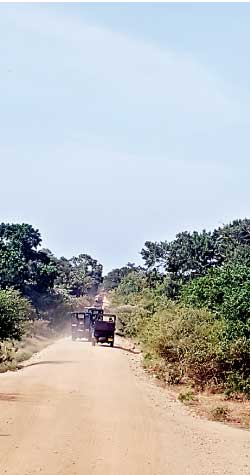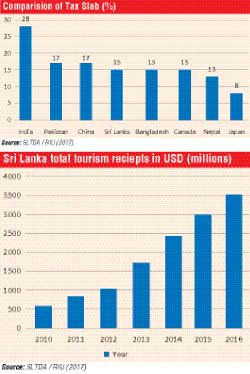Wednesday Apr 24, 2024
Wednesday Apr 24, 2024
Monday, 14 August 2017 00:01 - - {{hitsCtrl.values.hits}}

By Research
Intelligence Unit, Colombo
The tourism growth of Sri Lanka has seen a sharp increase from 1.79 million visitors in 2015 to 2.05 million visitors in 2016 whilst tourism related income generated has also increased significantly to become a vital contributor to the economy. Recent governments have initiated lots of infrastructure development initiatives that have helped to boost tourism such as the expansion of the Bandaranayke International Airport, the Southern Expressway and more recently, the Central Expressway which is set to further promote travel from Colombo to the central and northern places of interest once completed in 2020.
However, from the perspective of attracting international investors to Sri Lanka to invest, build and operate hotel and leisure projects, Sri Lanka is in a very competitive market. Whilst Sri Lanka’s tourist industry is still at a nascent stage of growth in terms of tourist numbers, the average daily rates and the revenues per room remain competitive within the overall Asian landscape. Moreover, despite the slow-down in the growth of arrivals since 2011, the island’s hotels still enjoy occupancy levels of around 70%, only bettered by Singapore.
In this context, the island is justifiably still within the prime target range for international hotel chains and developers as the market seeks its equilibrium. However, there are opportunities and risks from and within both geographic locations as well as market segments within Sri Lanka. For instance, we can note that the Western, Southern and Central provinces dominate the hotel inventory and new approvals index but investors will need to match their location feasibility with the emerging trends as well as be aware of entering geographic areas that have the highest future potential.
In a regional context, operating within the Asian space also has a positive side for countries that are quick on the uptake. For example, in July 2017, the Indian government introduced new goods and services taxes (GST) that have already witnessed the higher end of the Indian hotel industry being hit with up to 28% GST. Consequently, it has been reported that many corporates have already cancelled their MICE (meetings, incentives conferences and exhibitions) events and are looking at Thailand or Sri Lanka as an alternative option.
 MICE tourism is important for Sri Lanka and for Colombo and accounted for around 20,000 visitors. Similarly, health tourism has been growing at very positive levels as has the market share of business travel. Nevertheless, the pleasure travellers still make up some 83% of the market and are by far the most important market segment for the industry. Key markets include the UK, Western Europe, India and China.
MICE tourism is important for Sri Lanka and for Colombo and accounted for around 20,000 visitors. Similarly, health tourism has been growing at very positive levels as has the market share of business travel. Nevertheless, the pleasure travellers still make up some 83% of the market and are by far the most important market segment for the industry. Key markets include the UK, Western Europe, India and China.
From the demand perspective, both the private sector and the government will need to keep on inventing and initiating new ideas that will serve towards putting the island firmly on the map in a competitive international arena. In this regard, tourism marketing and promotion is as important as introducing easy visa systems and tourism safety initiatives. Whilst private sector initiatives and positive word of mouth feedback will help, a sustained effort will need the backing of key government agencies. In a sensitive international market that is dominated by social media and mass communication, a rise in dengue incidents for example can have a significant and immediate impact on bookings, as we have witnessed recently. In conclusion, the target of attracting four million tourists to Sri Lanka by 2020 seems realistic and archivable especially given that previous targets have for the most part been achieved and even bettered where the arrival numbers are concerned. However, given the limitations in the country’s infrastructure which is still in the process of being rolled out as well as a scarcity of ‘things to do’, especially for children, any serious challenge to the neighbouring destinations is not expected as far as the volumes are concerned.
Herein lies opportunity. On the one hand, an environment where the volumes are growing despite there being gaps in the market, especially for theme and amusement parks, should encourage developers into the leisure sector to cater to both the foreign visitors as well as the local tourist. On the other hand, it would be sensible for the policy makers to pursue quality rather than quantity, at least in the medium term until the infrastructure improvement efforts has made further progress and we have better connectivity in terms of drive times between major places of attraction.
However, there will be challenges in the drive to focus on quality in the absence of stricter controls and regulations that need to be designed in order to protect both the tourist and the islands natural environment. For example, one recent RIU study on Kalpitiya on the West Coast of the island has highlighted a huge potential for developing the tourism sector based on water sports and wild life and at the same time highlighted very serious concerns on sustaining an extremely sensitive natural environment characterised by lagoons, sandbanks, beaches, whales, dolphins and other marine life. Similarly, we can note that the Yala Wildlife reserve is currently swamped with an unlimited number of safari vehicles that have led to traffic jams within the reserve. When asked about the negative impact of this over-supply of safari vehicles, the officials claimed that there is currently no regulation in place to limit the number of vehicle despite the danger they pose to the wildlife its self. Clearly, myopic polices, or the lack thereof, will only lead to a cannibalisation of the very resources that have huge economic value to the country’s economy. The only solution is for both the public and private sector to work together in order to protect and expand the natural environment which will serve to position Sri Lanka at the higher end of the tourism market in the region which in turn will help to realise the true potential of the industry as a leading economic asset.
For more information contact: [email protected] /www.riunit.lk.
